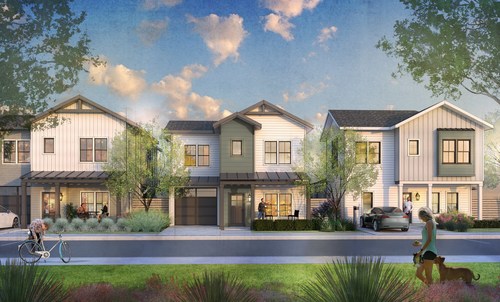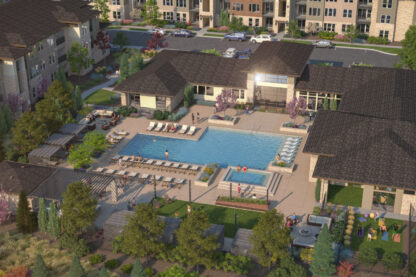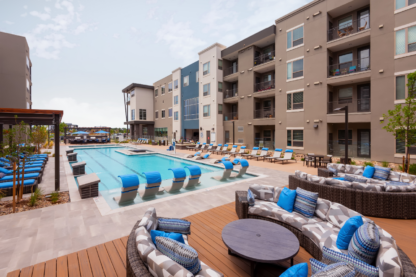Prepared by Jeanette Rice
Build-to-rent (BTR) housing growth has been phenomenal over the past six years. The first communities in the “modern era” of BTR appeared only around 2016, and the number of BTR communities has risen rapidly since 2018.
BTRs still represent a very small portion of all multifamily housing in the U.S., but BTRs have become a meaningful – and successful – part of the multifamily industry. They will play a much larger role in the years to come.
The product has gained wide appeal among multifamily developers, single-family homebuilders, institutional capital, and private investors.
Most importantly, BTRs have very broad appeal to the renter market. They provide the amenities and services of a conventional multifamily community, while offering a lower-density housing community with single-family like design features. The product offers the best of both multifamily and single-family rental living, especially important in an era where a high percentage of households cannot move into homeownership due to high for-sale housing costs.
WHAT IS A BTR COMMUNITY?
BTRs are multifamily communities. The key differences from conventional multifamily is that BTR communities are lower density and homes have limited adjoining units. BTRs have single-family type features, including typically a front yard, street entrance, attached garage, and private backyard. BTR home sizes are usually larger than multifamily units.
BTRs have the full slate of management services common to multifamily communities along with common-area amenities. These features make them appealing to individuals and families who might otherwise rent standalone single-family homes.
BTR housing should not be confused with the broader single-family rental (SFR) housing sector, which is largely comprised of existing standalone, non-contiguous rental homes. BTRs and standalone SFRs have similar resident profiles, and the rapidly growing interest and institutional investment in SFR housing are notable trends in the commercial real estate world. However, the development, management, and capital structures of BTRs are far different than SFRs.
ROBUST MULTIFAMILY DEMAND LONG TERM CREATES STRONG DEMAND FOR BTRS
BTR housing demand is positioned to expand greatly over the decade given BTRs’ early market success, design factors that give the product broad appeal, and general long-term multifamily trends.
- Multifamily demand is expected to remain robust long-term principally due to three macro trends:
America has a significant housing shortage. Over the past few decades, housing construction of all types has not kept up with household formation and housing obsolescence. Up for Growth estimates the country’s housing shortage today at nearly four million homes. The outlook is for a continued undersupply over the years to come. - A large portion of American households are staying in the rental market longer than previous generations by desire or by necessity. The most recent quarterly U.S. Census survey reported homeownership essentially stable at 66% and hence renter tenure at 34%.
- Entering into homeownership has become increasingly challenging due to high for-sale housing costs. Since 2011 (the housing price trough following the Great Financial Crisis), home prices have risen by 7.3% annually, much higher than inflation, wages, and apartment rents. The recent rise of home mortgage rates – 30-year fixed-rate mortgage climbing from 3.1% at the end of 2021 to the early December 2022 level of 6.5% – has further exacerbated the house affordability crisis. Home price appreciation has cooled in recent months, but prices have only inched down and are not expected to fall significantly in 2023.
BTR DESIGN MATCHES EVOLVING RENTER DEMOGRAPHICS AND PREFERENCES
Market demand for BTRs is also growing steadily due to BTRs’ design features – features which match the evolving demographics and consumer preferences of renters.
- With households staying in rental housing longer than previous generations, renter profiles are changing. Renters are getting older, raising kids, welcoming pets into their households, and acquiring possessions – all of which require space. These trends all match well with BTR features.
- Full- and part-time remote work necessitates more space at home for work activities. And, if one is driving to work less frequently, distance from employment matters less.
- BTRs can also be appealing to renters of standalone SFRs and to homeowners in transition (from moving to a new city, job relocations, marital changes, etc.). BTRs are particularly attractive because they are new. In comparison, the average age of standalone SFRs is roughly 25 to 30 years (based on the 27-year average of institutionally-owned SFRs in 2021 securitizations). BTRs offer community amenities, activities, and professional management services with onsite leasing and full maintenance and landscaping services usually not available to renters of standalone SFRs.
SUNBELT AND MOUNTAIN WEST METROS MOST ATTRACTIVE FOR BTR DEVELOPMENT
Most BTRs in the U.S. today are located in the rapidly growing metros of the Sunbelt and Mountain West regions. BTR development is concentrated in Texas (Dallas/Fort Worth, Houston, Austin, San Antonio), Tennessee (Nashville), North Carolina (Charlotte and Raleigh), South Carolina (Greenville, Charleston), Georgia (Atlanta), Florida (Orlando, Tampa, Jacksonville, Southwest Florida Coast), Arizona (Phoenix, which has the largest concentration of BTRs) and Nevada (Las Vegas). Colorado is emerging as a BTR market as well.
These metros are appealing due to strong population growth, especially from in-migration, and lower land costs. Other factors contributing to the higher levels of BTR development include less restrictive local regulatory environments and local development expertise.
SUBURBAN LOCATIONS DOMINATE BTR DEVELOPMENT
BTRs are nearly all suburban, and most are built in newer – and farther out suburban areas where larger tracts of land and greenfield sites are available at reasonable costs. While some BTR locations seem highly peripheral, these newer suburban areas are also generally very dynamic and are favorable choices for new households and in-migrants.
BTR developers favor higher-income areas (with their locational features of better schools, more attractive set of services and retail centers, and often employment centers nearby), but BTRs are also often located in middle-income neighborhoods.
CASE STUDY: EVOLUTION OF BTR IN SAN ANTONIO, TEXAS
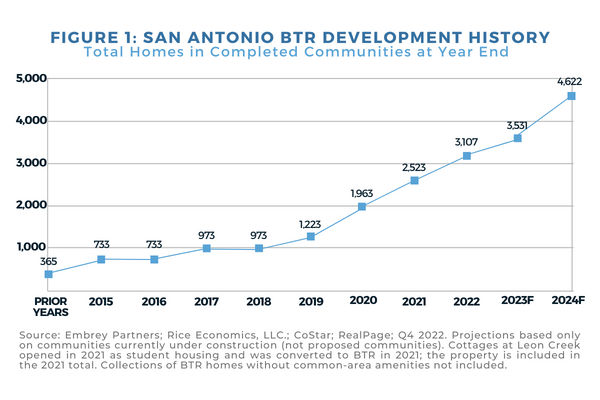
San Antonio’s BTR housing exemplifies how the product is evolving nationally, particularly the dramatic rise in development in the past four years.
Prior to 2019, San Antonio had only a handful of BTRs. AHV Communities’ Pradera community, which opened in 2019, brought renewed attention to BTR design and renewed recognition of BTRs’ broad appeal to renters.
Today, San Antonio has 15 completed communities with a combined total of 3,107 homes, (Figure 1). While BTR development is experiencing significant momentum, today’s total BTR home count represents only 1.6% of all multifamily homes in San Antonio (in properties with at least 50 units).
Six BTRs are under construction with completion dates spread out over the next two years. The communities will add 1,515 homes to bring San Antonio’s BTR total to 4,622 homes by the end of 2024.
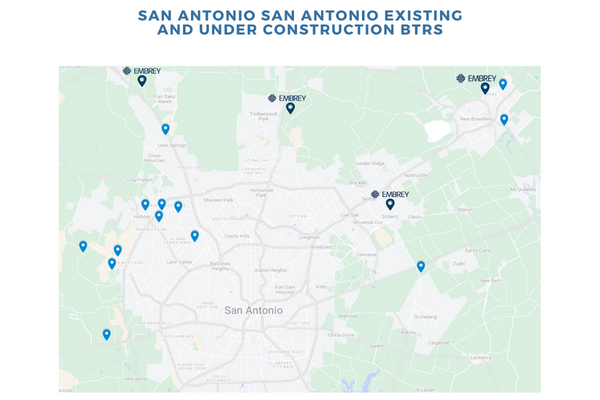
San Antonio’s BTR geography fits the general national patterns. BTRs are primarily located in the growth-oriented newer suburban areas of Northwest San Antonio, West San Antonio, and along the I-35 Corridor. The communities built in the past four years are an average 23 miles from the Alamo in downtown San Antonio, though it is likely that most BTR residents are employed in closer employment centers.
SAN ANTONIO’S BTRS PROVIDE MUCH NEEDED SPACE
A comparison between San Antonio’s existing BTR communities and 26 conventional multifamily communities built in the past four years in similar geography (same zip codes as the BTRs) sheds light on how BTR product differs from conventional multifamily.
The collective unit mix of San Antonio’s BTRs are 1% studio, 41% one- and two-bedroom, 47% three-bedroom, and 11% four-bedroom. In contrast, conventional multifamily units are 4% studios, 88% one- and two-bedroom, 7% three-bedroom and 1% four-bedroom. The average home size of BTRs is 1,365 square feet, considerably larger than multifamily’s 874 square feet.
CONCLUSION
The rise of BTRs is one of the most exciting trends within the multifamily industry today. BTR housing will play an increasingly important role for developers, investors and capital providers through the decade. BTRs will provide an important rental option for millions of Americans who rent.
BTRs have broad market appeal to a wide array of renters. BTRs help provide a solution to the broad undersupply of housing in America. The product’s single-family like design features are especially suited to market and consumer trends in today’s environment where renting is a long-term choice or necessity for a high percentage of American households. BTR will continue to be a very successful alternative to conventional multifamily and standalone SFR housing.
ABOUT THE AUTHOR
Jeanette I. Rice, CRE from Rice Economics, LLC, is one of the country’s leading multifamily economists. As the lead multifamily researcher at Embrey, Jeanette releases quarterly reports in collaboration with Embrey’s investment team, including high-level capital and property market analysis for the multifamily industry.


